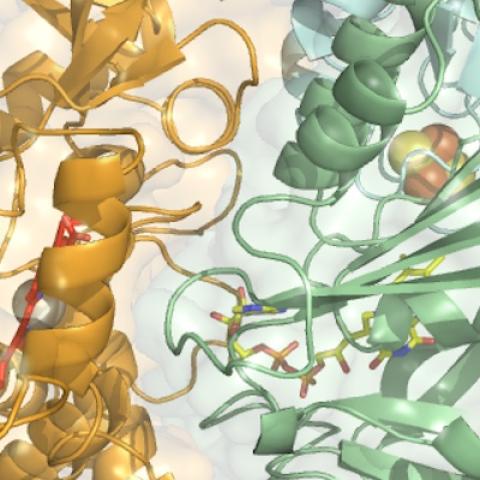
Our research in Ecology and Evolution aims to expand our knowledge of the diverse organisms that exist across the tree of life.
Our research deals with quantifying the diversity of the living world, from molecules to ecosystems. We search for new biotechnological potential in the genome of lesser-studied organisms. Through our explorations of the diversity of organism function and ecology, we create a basis for assessing the phase of rapid extinction which human beings are causing and struggling to prevent.
Our group addresses a range of ecological questions and issues such as pollutants within the environment, climate change, pollination dynamics, evolution of group living, molecular ecology, microbial dynamics and bioprospecting. We aim to inspire the public and demonstrate the value of scientific curiosity, by providing examples of the diversity of life and the unexpected capabilities of organisms.
We also have direct links with other leading centres at the University, including the Centre for Blue Governance, the Centre for Enzyme Innovation, the Institute of Marine Sciences, and the Institute of Biological and Biomedical Sciences.
Our research is regularly featured in publications such as Nature, Proceedings of the National Academy of Sciences of the United States, Nature Communications and Current Opinion in Chemical Biology – and recent funders of our work include Innovate UK, NERC, BBSRC, NC3Rs, Environment Agency, DEFRA, The Royal Society, the Crown Estate, the European Union (EU), the Heritage Lottery Fund, and Historic England.



Our research topics include:
Research in this topic focuses primarily on the evolutionary ecology of plants and the evolution of group living.
a) Evolutionary ecology of plants
We work on the evolution and ecology of plant-animal relationships, especially pollination. Tools used include quantitative genetics, molecular phylogenetics, and functional morphometrics. This research addresses broader questions about the origins, maintenance, and future of terrestrial biodiversity. These relationships are being modelled onto geographic scales through field studies, with a view to putting these species-species interactions into the context of multispecies interactions and community ecology. We also investigate sex polymorphisms in plants in relation to pollinators and their ability to promote pollen flow between different floral forms.
b) Evolution of group living
Our research seeks to understand how animals have evolved to reap the benefits of living, feeding, and breeding in groups while minimising the inevitable costs of competing with group members for limited resources. Our main model organisms are spiders, but other organisms such as wasps and ants are also being studied. Group living is only found in a small number of spider species. Some spider species are cooperative breeders, comparable to social groups of lions or primates. Other spider species are colonial, meaning that they live in groups but maintain solitary territories within the group. Spider groups can be formed by hundreds or thousands of individuals, and are mainly found in tropical and subtropical parts of the world. Within these magnificent groups, spiders show some fascinating behaviours such as hunting together, sharing food, building their silken nest together, and helping to protect and feed each other’s young.
c) Palaeoecology
Palaeoecology can help us to understand ecosystem change over time by using sedimentary records to characterize the past diversity of species, and track how communities respond to factors such
Research in this topic focuses primarily on the population genomics of adaptation, phylogenomics, and the evolution of genome organisation.
Our research examines how selection, history and intrinsic properties of genomes act on genetic diversity and speciation in natural populations. We combine genetics and genomics with the study of environmental variation and ecology.
a) Population genomics of adaptation
Our research examines the genetic diversity of domesticated species and their wild relatives (such as flax and date palm) to identify locally adapted genes and understand the molecular mechanisms through which species adapt. We also use the tools provided by population genomics to investigate the extant genetic diversity and resilience of endangered species (such as the Greek tortoise in Spain and the Reunion harrier). Our research also focuses on enzymes of value for biofuel generation. We are developing transcriptomic and genomic resources for wood-consuming marine organisms to determine which proteins are produced during the digestive process. This work will pave the way for the discovery of new enzymes for biodegradation. The first output of the Gribble Genome Project is the mitochondrial genome. We use transcriptomic approaches to characterise the effects of parasites on gene expression in crustaceans and to detect markers for gender expression in animals subject to pollution
b) Phylogenomics
The reconstruction of genealogical relationships between taxa or individuals through the comparison of DNA sequences is a powerful tool to understand the evolution of species and communities through time. We examine the evolutionary processes producing diversity using phylogenetic methods at short and long timescales. Our work has particularly focused on the diversification of plants taxa, and the development of efficient methods to sequence low-copy nuclear genes across diverse taxa (e.g. Angio353). Our group also contributed to the phylogenetic study of the SA
Research in this topic focuses primarily on antimicrobial resistance in the environment and bioremediation; environmental monitoring, and microbial ecology.
a) Antimicrobial resistance in the environment and bioremediation
As shown by the COVID-19 pandemic, microbiology has a huge impact on our everyday lives and health. Understanding how microbes interact and persist in the environment is essential — with far reaching implications from biogeochemistry, global ecosystem functions and human health. We apply molecular tools to better understand microbial diversity and interactions in the environment. These analyses fall into two main areas: the degradation of recalcitrant natural products, persistent organic pollutants and solid polymer substrates for industrial applications; and antimicrobial resistance in aquatic environments, especially its transfer and concentration in environments affected by wastewater releases and in aquaculture systems.
b) Environmental monitoring
Our ecotoxicology and environmental monitoring research examines how humans impact upon aquatic (marine and freshwater) and terrestrial ecosystems. We also explore the ecological consequences of human activity and seek to develop new methods to assess human impact on the environment. With climate change and pollution becoming more pressing concerns, our research is helping inform better policy decisions and exploring how we can protect our environment in a sustainable way.
Our research outputs are regularly published by leading industry publications, including Global Climate Change, Aquatic Toxicology, Environmental Pollution and Science of the Total Environment. We have exceptional facilities that play an important role in our work, including the seawater flow-through aquarium facilities at the Institute of Marine Sciences, our research platform in Langstone Harbour, the Petersfield Waste Water Treatment facility, and our research vessels, greenhouses, microscopy suites, and molecular and
Recent research outputs
Genomic insights into diverse bacterial taxa that degrade extracellular DNA in marine sediments
Wasmund, Kenneth, Pelikan, Claus, Schintlmeister, Arno et al. In: Nature Microbiology. 2021, Vol. 6, No. 7. pp. 885-898.
Pérez-Escobar, Oscar A., Bellot, Sidonie, Przelomska, Natalia A. S. et al. In: Molecular Biology and Evolution. 2021, Vol. 38, No. 10. pp. 4475-4492.
Bourgeois, Yann, Fields, Peter, Bento, Gilberto et al. In: Molecular Biology and Evolution. 2021.
Newsome, Laura, Falagán, Carmen. In: GeoHealth. 2021, Vol. 5, No. 10.
Prey to predator body size ratio in the evolution of cooperative hunting—a social spider test case
Grinsted, Lena, Schou, Mads F., Settepani, Virginia et al. In: Development Genes and Evolution. 2020, Vol. 230, No. 2. pp. 173-184.
Manzano, Saúl, Julier, Adele C.M., Dirk, Cherie J. et al. In: Restoration Ecology. 2020, Vol. 28, No. 6. pp. 1335-1342.
Our facilities
Our facilities allow us to conduct research ranging from molecular to genetics, to ecology and marine sciences. We have access to Nuclear Magnetic Resonance (NMR); analytical ultracentrifugation (AUC) facilities, and next generation DNA sequencing facilities are provided by the Oxford Nanopore GridION platform.





You can read more detailed information about our facilities by following one of the links below.
Discover more Biology research
Biophysics and Molecular Genetics Research Group
We're studying biomolecules such as DNA, RNA and proteins to allow us to tackle issues such as disease, pollution and energy.

Marine Biology Research Group
We're researching key environmental issues in marine science such as climate change, biodiversity loss, habitat degradation and ocean acidification.

Biological Sciences
We're exploring how to treat genetic disorders, identifying novel targets for drugs and searching for advances in treatments that could impact millions.







